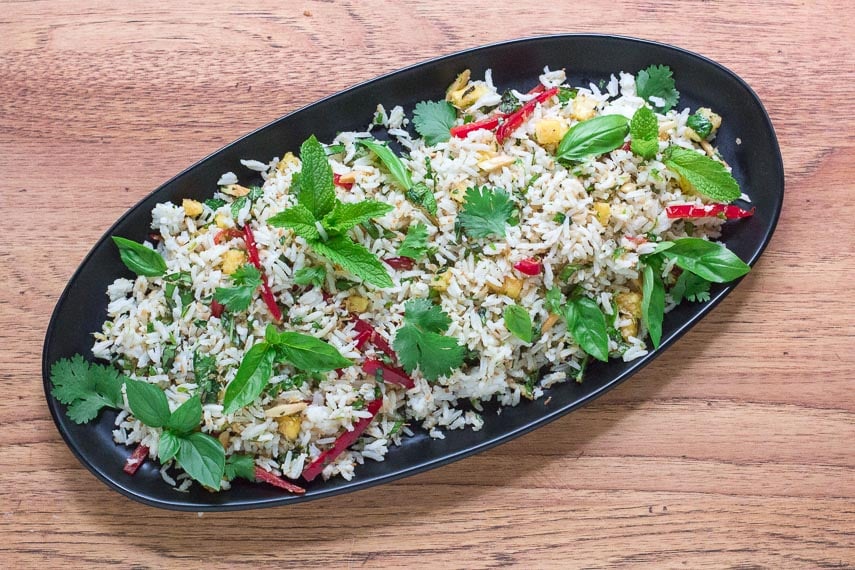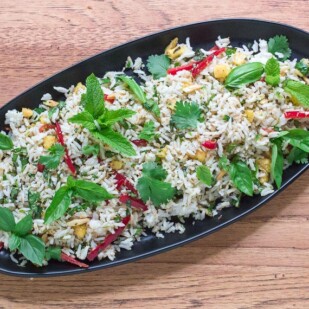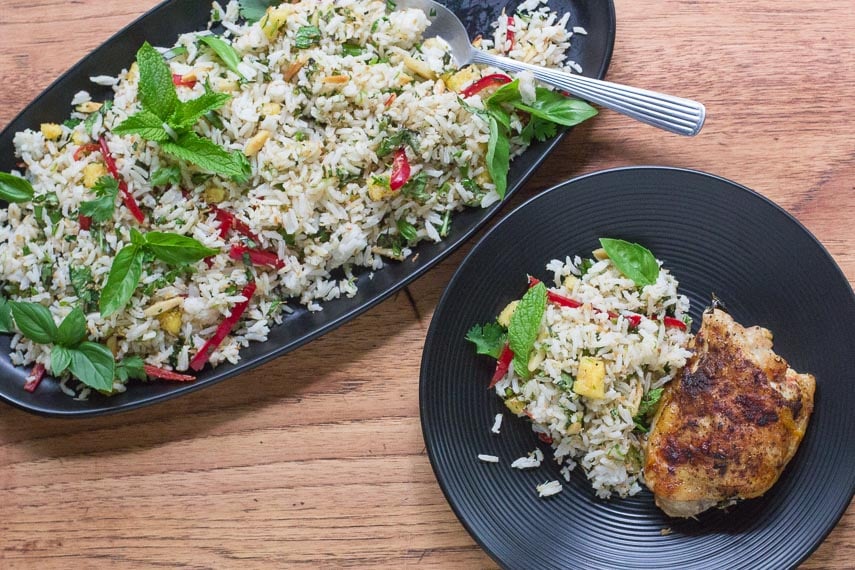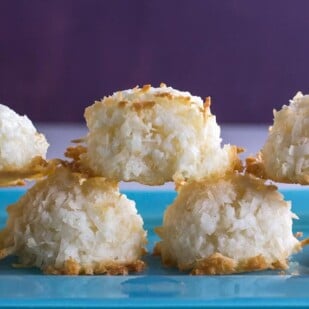Low FODMAP Coconut Rice Salad is Versatile
Our low FODMAP Coconut Rice Salad with Pineapple & Herbs is good warm or at room temperature and works just as well as a side dish at dinnertime as it does as a main dish for lunch.

Basmati rice is combined with toasted coconut and slivered almonds, diced fresh pineapple, red bell pepper, scallions and a flavor packed combo of fresh mint, cilantro and basil.
Make sure to use uber-fresh herbs! The dressing is salty and tangy with umami flavor from the fish sauce, which is balanced by the lime juice.
Make Rice Ahead
This works well with rice that is cooked the same day and cooled – or you could use leftover rice.
Just make sure it isn’t chilled or the texture will be too hard and unpalatable.
Check out our recipe for Cilantro Lime Rice, too. We think you will like it. Our salad featuring Forbidden rice, too, with sesame and kale.

Low FODMAP Coconut Rice Salad with Pineapple & Cilantro
This Low FODMAP Coconut Rice Salad with Pineapple & Cilantro makes a great side dish for roasted or grilled meats and poultry.
Low FODMAP Serving Size Info: Makes about 6 cups (1.14 kg); serving size about ¾ cup (140 g)
Ingredients:
- 2 tablespoons coconut oil or FODY Shallot-Infused Olive Oil divided
- 1/2 cup unsweetened desiccated coconut, (which is very finely ground), or unsweetened long-shred flaked coconut
- 1/4 cup (27 g) sliced or slivered blanched or natural almonds
- 4 cups (760 g) cooked basmati rice, cooled to warm or room temperature
- 1/2 a medium red bell pepper, cored and julienned
- 2/3 cup (10 g) fresh lightly packed basil leaves, torn or chopped
- 1/2 cup (8 g) fresh lightly packed cilantro, torn or chopped
- 1/2 cup (8 g) fresh lightly packed mint leaves, torn or chopped
- 1/2 cup (85 g) finely diced fresh pineapple, (see Tips)
- 1/2 cup (32 g) finely chopped scallions, green parts only
- Zest 1 lime
- 1 tablespoon plus 1 teaspoon lime juice, or to taste
- 1 tablespoon fish sauce, such as Red Boat brand, or to taste
- Kosher salt
- Freshly ground black pepper
Preparation:
-
Add 1 tablespoon of the coconut oil or FODY Shallot-Infused Olive Oil to a nonstick skillet and heat over medium heat. Add coconut and almonds and toss frequently, cooking just until beginning to take on some color - a mere few minutes. Remove from heat; scrape into a large mixing bowl and set aside.
-
Add rice to the bowl, then add julienned red pepper, basil, cilantro, mint, pineapple and scallions. Toss everything together well. Add reserved tablespoon of oil, zest of lime, 1 tablespoon plus 1 teaspoon of lime juice and 1 tablespoon of fish sauce. Toss to coat, taste, season with salt and pepper and add more fish sauce and or lime juice if needed to balance flavors.
Notes:
Tips
- Pineapple is low FODMAP in amounts of 1 cup, chopped (140 g). We particularly like “gold” pineapples, which have a richly golden color as they are always sweet. If you must, you could use canned pineapple packed in juice (not heavy, sugary syrup). Buy the rings and dice them to the correct size; the crushed style is too mushy.
Nutrition
All nutritional information is based on third-party calculations and should be considered estimates. Actual nutritional content will vary with brands used, measuring methods, portion sizes and more. For a more detailed explanation, please read our article Understanding The Nutrition Panel Within Our Recipes.









This was such a hit at last night’s dinner! You absolutely have to try this one, people. It comes together easily and is such a great departure for the same-old-same-old white rice. I had to sub flat-leaf Italian parsley for the cilantro as my mother “tastes soap” when she eats cilantro (poor woman) but that’s the only change I made. I love cilantro but I wanted her to be able to enjoy the dish as well. I use Red Boat Fish sauce. I tried another brand when I first started using fish sauce in my cooking and was really turned off by its flavor. Since Michelle Tam (Nom Nom Paleo) uses Red Boat all the time in her dishes I decided to give fish sauce another try. The difference in the brands was so, so noticable. So, if you’re on the fence about using fish sauce, definitely go with Red Boat. I am so excited to try more of Dede’s recipes!!!
We are fish sauce twins! Anyone reading this, believe what she says, as I am beating that drum all the time as well. Some fish sauce brands (MANY) are so harsh as to be unpalatable. Red Boat is a fantastic condiment and can make the dish a winner. I so appreciated you commenting on this recipe because it is a bit of a sleeper recipe. It doesn’t have the WOW factor that so many do – and yet, as you found out, it is a delicious and EASY accompaniment that can even be served to non-FODMAPers. Thank you for being an enthusiastic part of our community.